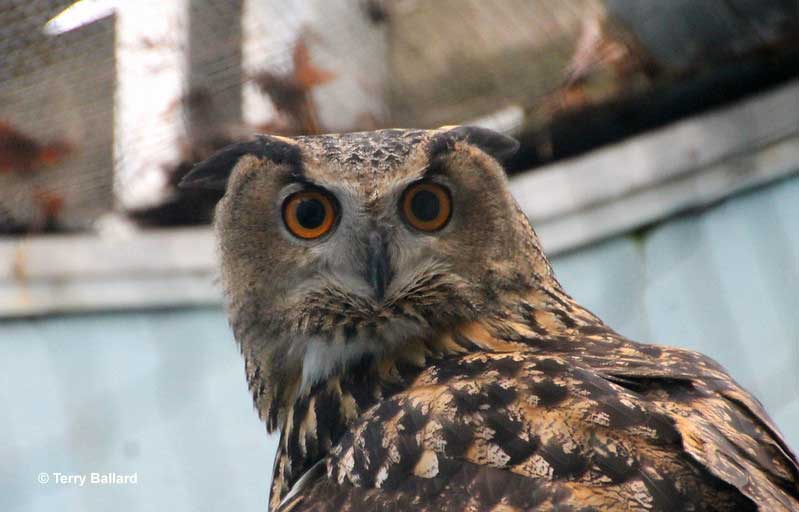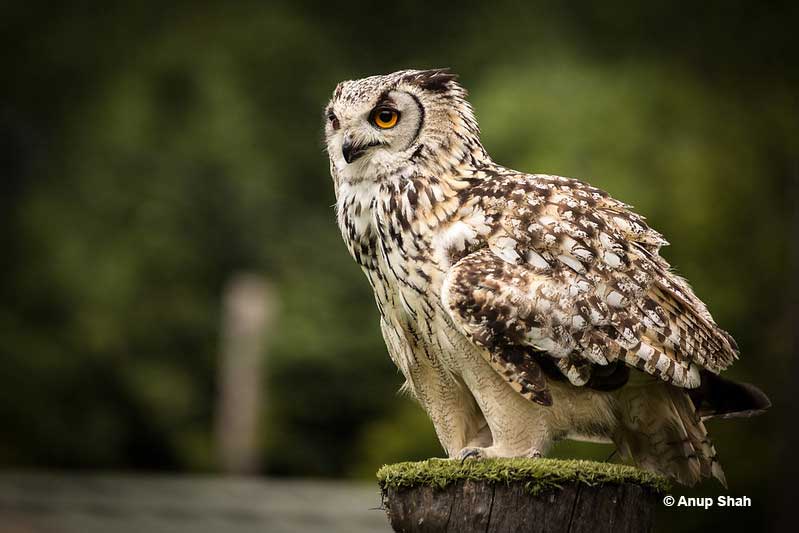
Some time ago, I heard an interesting statement that there are no owls in New York City.
To be honest… lots of owls live in New York!
Go birding in wild areas of New York state and you might see Great Horned Owls, Barred Owls, Eastern Screech-Owls, and other species.
But how many owl species live in New York state? Which owl species are rare and which are common?
Most Common Owls In New York
The Empire State is inhabited by different owl species, but in order to find out which, we leaned on eBird data. With multiple species, there’s much to see!
There is a real gem coming, too! An Eurasian Eagle Owl called Flaco, who was a Central Park Zoo inhabitant and later an escapee. Unfortunately, he passed away in early 2024.
Great Horned Owl
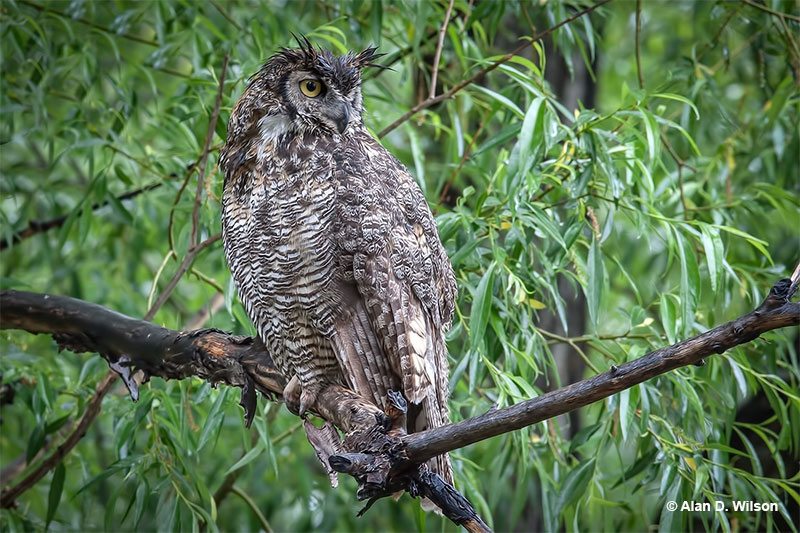
- Range: Permanent resident in much of Alaska, Canada, and the USA.
- Length: 22 inches
- Wingspan: 44 inches
- Call: Makes a low, gruff, “hooo, hoo hoo hoo hoooo”.
The Great Horned Owl is a big, bulky owl with big ear tufts and a black beak. It is mottled gray and brown, has a rufous or gray face, and fine black barring on its underparts. This owl also has a white throat and some dark marks on its breast.
Males and female Great Horned Owls look the same but females are larger. They also have a medium-length tail with dark bands, and long, broad wings.
This nocturnal owl species lives in every possible habitat, including urban areas.
Key Identifications:
- Big, bulky brown or gray owl with ear tufts and fine barring on its underparts.
- Nests in old stick nests of other large birds, on ledges, and in other situations.
- Watches from a perch or glides over open habitats at night, to catch mammals and some birds on the ground.
Barred Owl
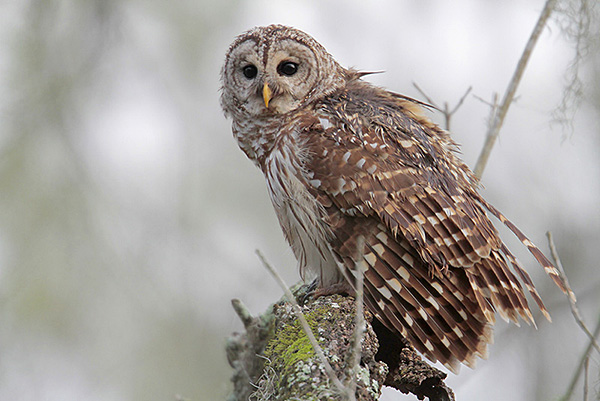
Photograph © Greg Lavaty.
- Range: A permanent resident in most forested areas in Canada, parts of some Pacific Northwestern states, and most of the eastern USA.
- Length: 21 inches
- Wingspan: 42 inches
- Call: Makes loud hooting and caterwalling sounds, “Who cooks for you?! Who cooks for youaaaal!”
The Barred Owl is a medium to large owl with a round head and a narrow black border on its pale gray face. It has dark brown upperparts with white markings, and dark brown streaks on its belly.
This species also has a yellowish beak and dark eyes. Both sexes look the same except that females are a bit larger than males.
The Barred Owl flaps and glides on big, broad wings. It also has a medium-length, broad tail with a few dark brown bands. They live in deciduous and coniferous forests and woodlands.
Key Identifications:
- Big owl with a round head that has white marks on dark brown upperparts, and dark brown streaks on pale underparts.
- Perches and swoops through wooded areas at night but can also be active in the day.
- Nests in tree cavities and in abandoned nests of crows and hawks.
- Catches a wide variety of small animals.
Eastern Screech Owl
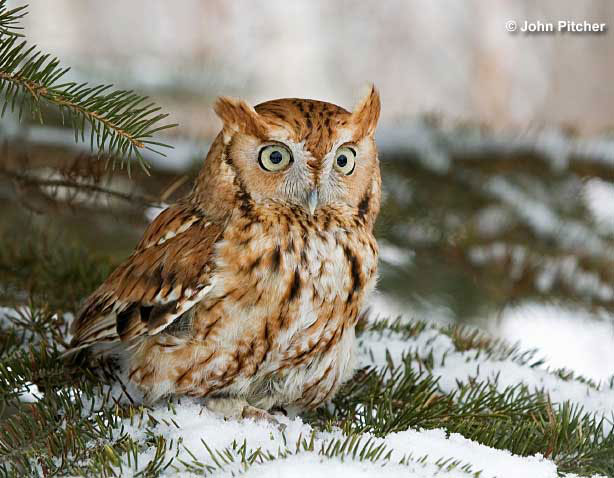
- Range: Permanent resident in parts of southeastern Canada, and in much of the eastern USA.
- Length: 8.5 inches
- Wingspan: 20 inches
- Call: Makes a rather high-pitched, descending whinny call, and a tremulous, vibrating call on the same pitch, “wududududududududududu”.
The Eastern Screech Owl is a small owl with ear tufts. It can be reddish, brown, or mostly gray, has “V”-shaped pale eyebrows, and some black on the edge of its face. It is also mottled above with some white spotting, and has pale underparts with dark barring and streaks.
Males and females look alike but females are a bit larger. This species also has yellow eyes, a pale yellow-gray beak, and some white bands on its broad tail.
Eastern Screech-Owls flap and glide on long, broad wings.
During the day, this owl hides in holes, or in dense vegetation.
Key Identifications:
- Small owl with ear tufts and mottled brown or gray plumage that lives east of the Rocky Mountains.
- Lives in a variety of wooded and park-like habitats.
- Nests in tree cavities and nest boxes.
- Swoops down to the ground catch a variety of small animals at night.
Eurasian Eagle Owl
- Range: Parts of western and southern Europe to central and eastern Asia.
- Length: 22 to 27 inches.
- Wingspan: 62 to 74 inches.
- Call: Makes a loud, single note, “hooo!”.
The Eurasian Eagle-Owl is a huge Eurasian owl that resembles the related Great Horned Owl in a number of ways.
However, unlike the Great Horned in North America, Eurasian Eagle Owls only live in zoos. On February 2, 2023, with help from an unknown person, one escaped from the Central Park Zoo in New York City!
Known as Flaco, this eagle-owl frequented the Central Park area and other parts of lower Manhattan for more than a year. Although zookeepers were concerned that Flaco might not know how to hunt, he had no problem catching rats and pigeons.
Over the course of 2023, Flaco ended up becoming one of the most famous New Yorkers in the city. Both birder and non-birders alike looked for him and, once in a while, he also perched on balconies to stare into people’s apartments!
Sadly, Flaco died on February 24th, 2024 after colliding with a building on West 84th Street. Autopsies showed that the poor owl had been suffering from disease and rat poison and would have died anyway.
Key Identifications:
- Big, tawny owl with ear tufts, red-orange eyes, and dark streaks on its chest.
- Lives in forest and rocky areas. In North America, only occurs in zoos.
- Nests in old stick nests made by other large birds, and on rocky ledges.
- Watches from a perch or glides over open habitats at night to catch mammals and birds on the ground.
Northern Saw-whet-Owl
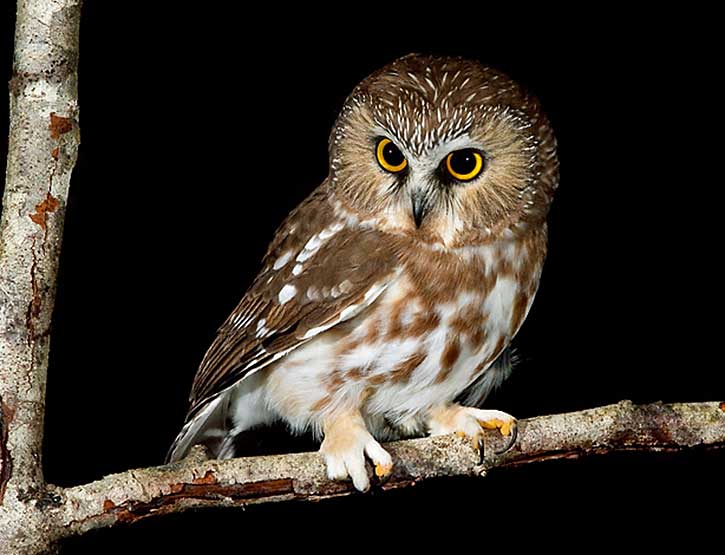
- Range: Lives in coniferous and mixed hardwood forests of Alaska, a large area of Canada, and parts of the northern and western USA.
- Length: 8 inches
- Wingspan: 17 inches
- Call: Makes a repeated tooting whistle call, over and over, “tu, tu, tu, tu, tu, tu, tu, tu, tu”.
The Northern Saw-whet Owl is a small, dark brown owl with a round head and brown streaks on white underparts. It also has some pale streaks on its head, a brown and white face, and some white spotting on its back.
Both sexes look the same but females are a bit larger. This species also has yellow eyes, a dark beak, longish, rounded wings, and a short, broad tail.
This nocturnal owl lives in forested habitats.
Key Identifications:
- Small, dark brown owl with a round head, broad white eyebrows, and thick dark streaks on pale underparts.
- Occurs in dense coniferous and mixed forest.
- Nests in old woodpecker holes and can use nest boxes.
- Swoops down to catch insects and small animals at night.
Short-eared Owl
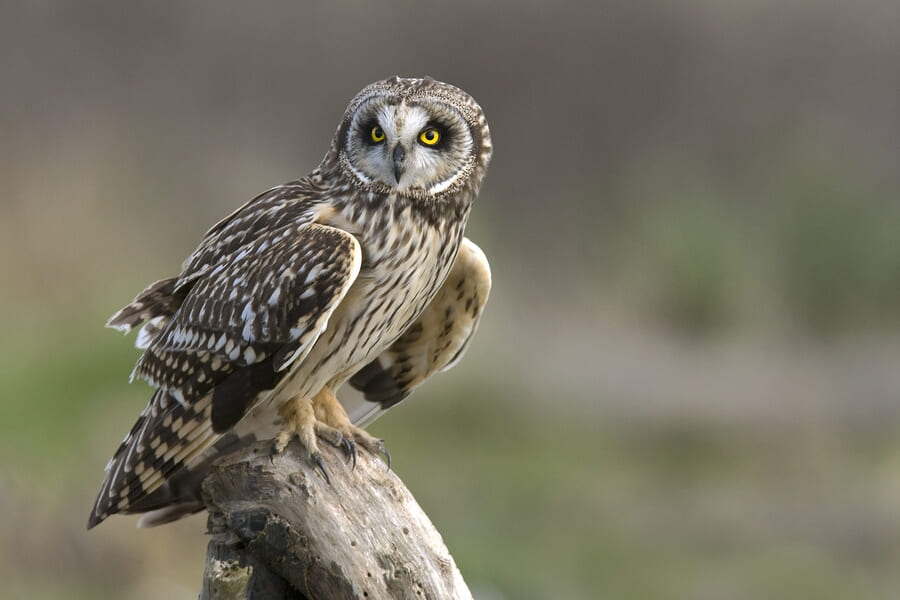
- Range: Summer resident in Alaska, Canada, and the western and central USA. Northern birds migrate to the USA, south to California and Texas.
- Length: 15 inches
- Wingspan: 38 inches
- Call: Makes a hoarse, raspy, cat-like call, “rehw”.
The Short-eared Owl is a medium-sized, pale brown owl with dark eye patches on a pale face. They have a dark breast and streaks on pale underparts. This species has long wings with buff wing patches.
Both sexes look similar but females are a bit larger and usually darker and buffier.
This owl is active day and night in open fields.
Key Identifications:
- Medium-sized pale brown and buffy owl with very short ear tufts.
- Dark eye patches on a pale face and long wings with buff patches near the wingtips.
- Nests on the ground in dense vegetation.
- Glides over open fields to catch small animals on the ground.
Barn Owl
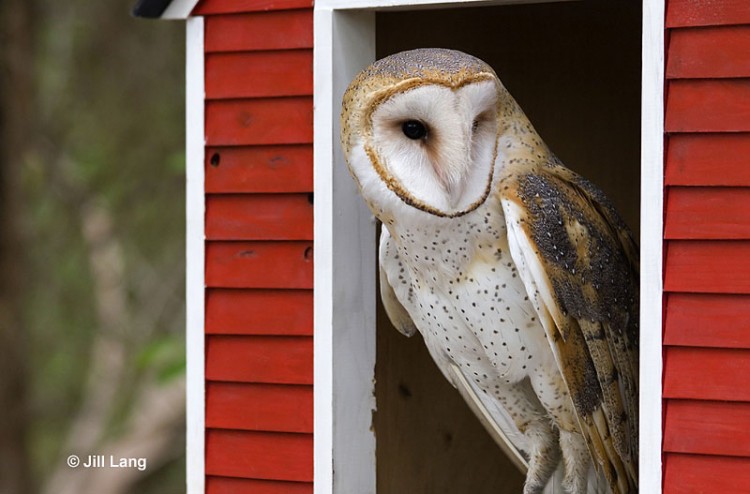
- Range: In Canada, occurs mostly in southwestern British Columbia. In the USA, they live in many areas but are absent from mountains and cold, northern regions. They range north to Washington, Nebraska, Iowa, and New York.
- Length: 16 inches
- Wingspan: 42 inches
- Call: A shrill, loud, hissing “shriiiiii!”
The Barn Owl is a medium to large, pale owl with golden tan and gray upperparts, and white underparts. It has a distinctive, white, heart-shaped face.
Both sexes are alike but females are a bit larger than males and have buff on their chest.
In flight, Barn Owls look like a large, pale, moth-like bird with a big, rounded head.
This owl hunts in grasslands, farms, and other open habitats.
Key Identifications:
- Large pale owl with a heart-shaped face.
- Glides and flutters over fields and other open areas at night.
- Nests in tree cavities, crevices in church steeples and other structures, and next boxes.
- Preys on rats and other small animals.
Long-eared Owl
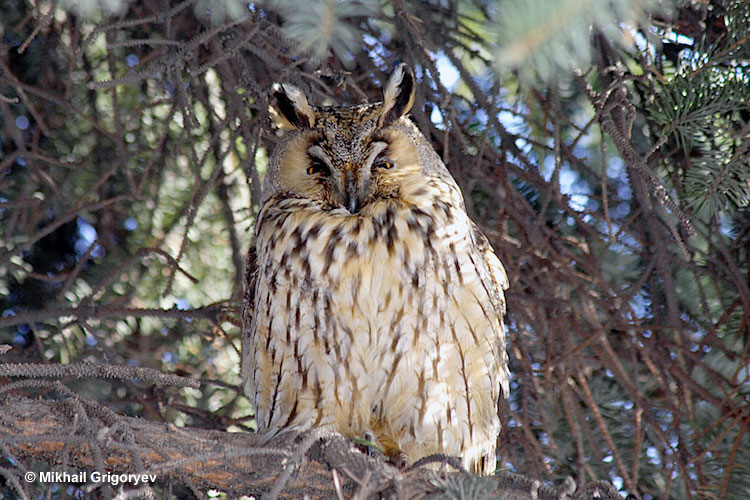
- Range: Migrant in southern Canada, resident and winters in much of the USA. Absent from parts of the Pacific Northwest and southeastern states.
- Length: 15 inches
- Wingspan: 36 inches
- Call: Makes a single, one second long “Hooo!” call at regular intervals.
The Long-eared Owl is a medium-sized, slender owl with long ear tufts. It has an orange face, is mottled gray above, and has dark brown streaks and marks on pale underparts. This owl also has long wings with a rufous patch in its primaries.
Male and female Long-eared Owls look similar but females are larger. This owl species also has yellow eyes, and some pale markings between its eyes and around its dark beak.
This nocturnal owl frequents coniferous woodlands near meadows.
Key Identifications:
- Medium-sized, slender owl species with long ear tufts, orange on its face, and long wings with an orange-brown patch near the wingtips.
- Occurs in coniferous and mixed forests near meadows, bogs, and other open areas.
- Nests in old crow, magpie, and hawk nests.
- Glides over open habitats near forest at night to catch small animals on the ground.
Snowy Owl
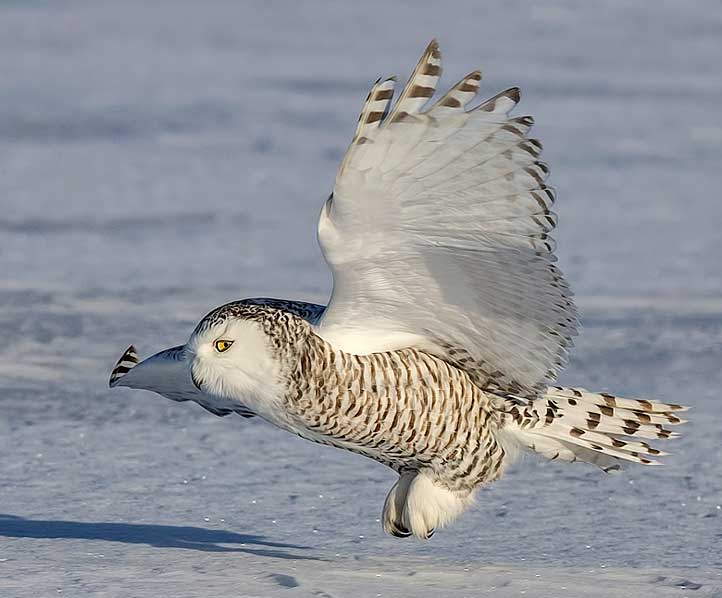
- Range: Summer resident in northern Alaska and northern Canada. It winters in Canada and the northern USA.
- Length: 23 inches
- Wingspan: 52 inches
- Call: Usually quiet but occasionally makes a low, gruff call, “whew…whuh”.
The Snowy Owl is a big, mostly white owl with a round head and yellow eyes. Some males are mostly white but most have some small dark marks. Females and young birds have white faces and varying degrees of black barring.
Females are a bit larger than males and have more black markings than males. Snowy Owls also have long, broad wings and a broad tail.
This owl species is active during the day and lives in wide-open habitats.
Key Identifications:
- Big white owl with a round head, and varying degrees of black or dark gray barring and spots.
- Lives in tundra and winters in wide open habitats.
- Nests on the ground, on elevated spots in Arctic tundra.
- Watches from a perch and glides low to catch small animals on the ground.
Boreal Owl
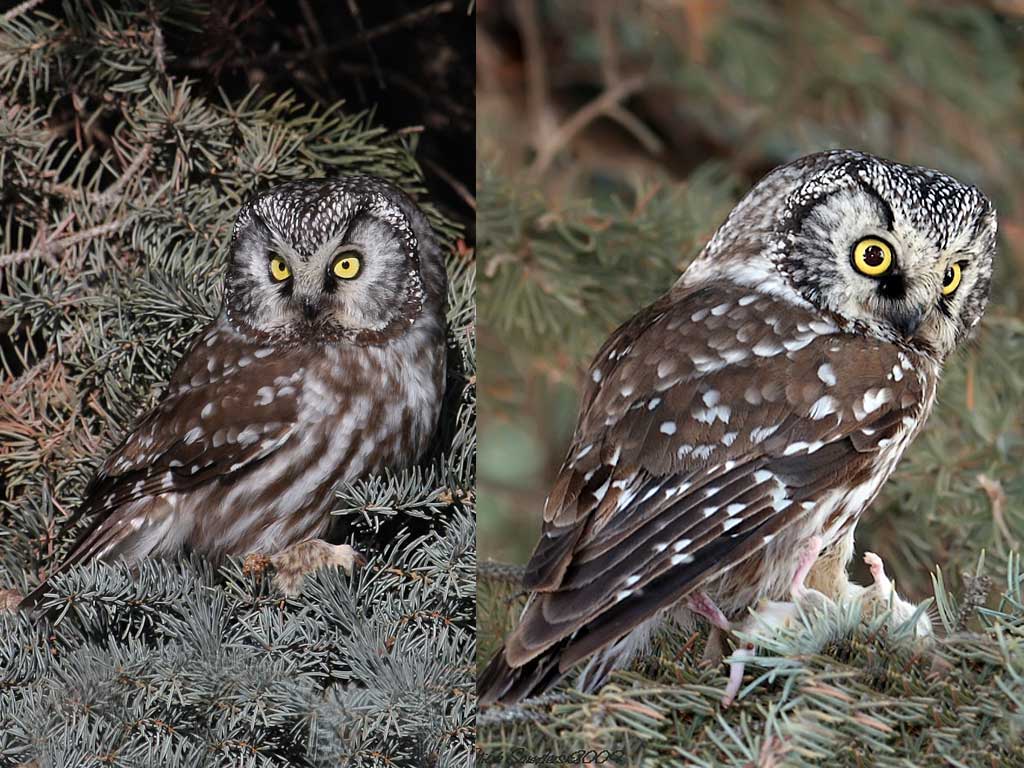
Boreal Owl
- Range: A permanent resident in a large part of Canada, Alaska, and parts of the Cascades and Rocky Mountains. Some migrate to southern Canada and the northern USA. Common in %STATE%.
- Length: 10 inches
- Wingspan: 21 inches
- Call: Makes a slightly rising, rapid serious of twelve brief hoot notes, “too, too, too, too, tu, tu, tu, tu, tu, tu, tu, tu”.
The Boreal Owl is a small owl species with a round or square-shaped head, and white face with a broken black border. It is dark brown with white spotting and has a black and white head.
Males and females look alike although females are larger. This species also has yellow eyes, and a pale beak. Juvenile birds are mostly dark brown.
Boreal Owls have a few pale narrow bands on a broad tail, and glide on long, broad wings.
Key Identifications:
- Small, dark brown and white owl with white spotting and a squared, black and white head.
- Lives in boreal and montane forest, some also winter at lower elevations and just south of its breeding range.
- Nests in old woodpecker holes and nest boxes.
- Watches from a perch before swooping down onto small animals at night.
Frequently Asked Questions
Now many owl species does New York have?
New York has 13 owl species. However, one of those is a species that escaped from a zoo, and three others are rare visitors to the state.
Do owls live in NYC?
Yes, owls live in NYC. Five owl species occur in the city. Three species live in New York parks all year long, two species are winter visitors, and one, the Barn Owl, is a very rare migrant.
Where can I see owls in New York?
You can see owls in New York in parks and other protected areas, forest, and many other natural habitats.
More in New York State: Most common birds | State Bird


